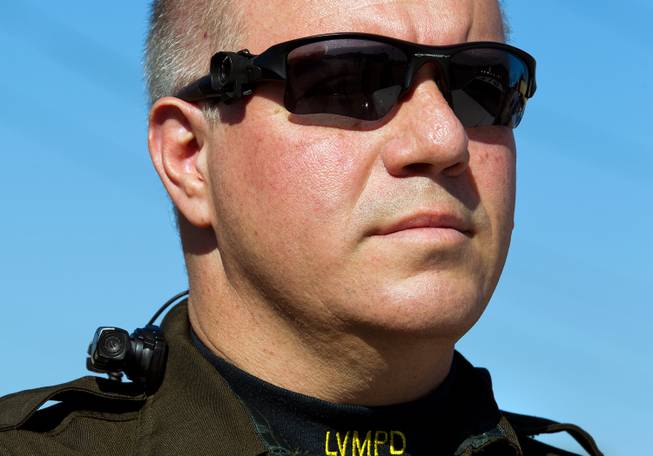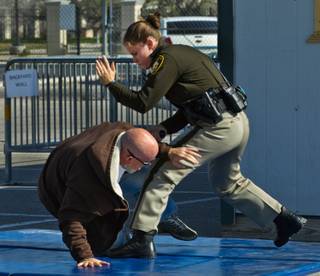
Metro Police Sgt. Peter Ferranti with a body-worn camera on his shoulder during a media event Wednesday, Nov. 12, 2014, at the Mohave Training Center.
Wednesday, Nov. 12, 2014 | 6 p.m.
Touting body cameras as the greatest technological advancement since the police radio, Metro Police officials on Wednesday announced the start of their federally sponsored study for the gadgets.
The study, which was initially scheduled to begin by February, is part of a pilot program for the $1.6 million camera system that outfits 197 officers who work in the northeast valley and in West Las Vegas.
At a media show and tell on Wednesday, police officers demonstrated the cameras and simulated officer-involved shootings to show how the cameras work.
Here are four takeaways on the presentation:
The research project, carried out by the National Institutes of Justice and CNA Analysis and Solutions, will examine the camera’s effects on perceptions of officer misconduct and their potential impact on police relations with the public.
“No study has looked at a jurisdiction as large or laborious as Las Vegas,” said Bill Sousa, a UNLV criminal justice professor who is helping oversee the project.
Sousa said the study will examine the behavior of two groups of officers who are participating in the study — 197 are wearing cameras, while 190 are not.
Sousa previously told the Sun that the study could have some surprising results. Anecdotal evidence from earlier studies suggests the cameras could lead officers to dole out more citations for minor infractions.
Metro has gotten some federal funding for the project, but most of the money will probably ultimately come from its budget. The most expensive part of the project is the software and wiring for the camera system.
The U.S. Department of Justice gave Metro a $107,000 grant for the program, and local officials are trying to secure an additional $95,000 grant. That funding only covers a fraction of the project’s $1.6 million cost.
Each camera costs about $500 apiece. But the system to support the cameras is far more expensive. That includes wiring, software and an video archive system. The pilot project's wiring system alone runs $55,000.
The cameras — no bigger than a marker — can be worn several ways.
They can be clipped onto mounts that can be worn either on the shoulder, on a pair of glasses on a collar or behind the head.
Most officers prefer to wear them around the collar of their uniforms because that’s generally the most comfortable option and the camera doesn’t shift around much, said Lt. Dan Zehnder, who heads Metro’s patrol support division.
The least popular option is the mount that is worn behind the head because it tends to slip off, especially on officers with longer hair. Perhaps more importantly, “nobody wants to wear that because they look goofy,” Zehnder said.
There are potential pitfalls.
While officers can’t tamper with the footage or edit what gets recorded, they can turn the device off while they’re on duty.
The footage on the cameras isn’t stored automatically. Officers must first dock their cameras at a police station in order to upload their footage.
An officer could damage or misplace a camera holding footage that hasn’t been uploaded.


Join the Discussion:
Check this out for a full explanation of our conversion to the LiveFyre commenting system and instructions on how to sign up for an account.
Full comments policy